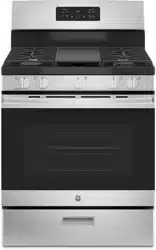Documents: Go to download!
User Manual
- User Manual - (English, French)
- CONVERSION INSTRUCTIONS - (English)
- Installation Instruction - (English)
User Manual Range
USING THE COOKTOP
In Case of a Power Failure
In the event of a power failure, the oven is inoperable and no attempt should be made to operate it. However, the surface burners may be lit with a match. Using extreme caution, hold a lit match near the ports beneath the surface burner cap, then slowly turn the knob to the LITE position. Once lit, surface burners will continue to operate normally
Surface Burners
Lighting a Surface Burner
Make sure all burners are in their correct locations and fully assembled before attempting to operate any burner. Select a burner and find its control knob. Push the knob in and turn it to the LITE position.
You will hear a clicking noise— the sound of the electric spark igniting the burner. When one burner is turned to LITE, all burners will spark. Sparking will continue as long as the knob remains at LITE. Once gas is ignited, turn the knob to adjust the flame size.
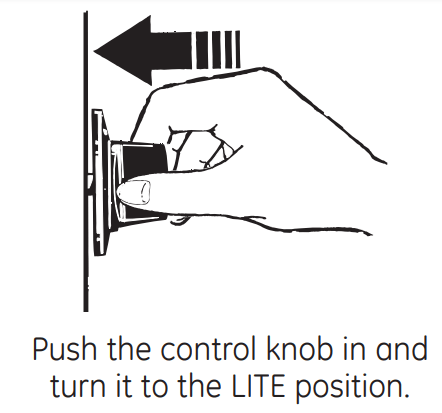
Selecting a Flame Size
Watch the flame, not the knob, as you adjust heat. When rapid heating is desired, the flame size should match the size of the cookware you are using. Flames larger than the bottom of the cookware will not heat faster and may be hazardous.
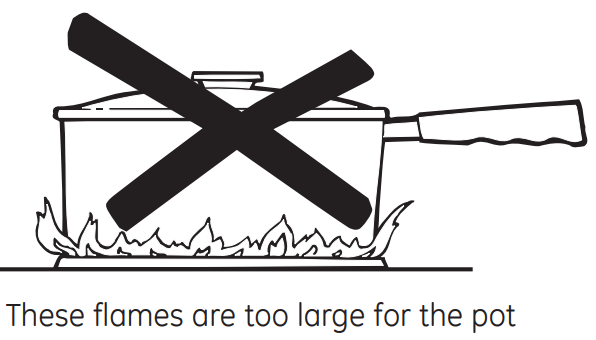
Using the Surface Burners
NOTES:
■ Do not operate the burner for an extended period of time without cookware on the grate. The finish on the grate may discolor or chip without cookware to absorb the heat.
■ Do not attempt to disassemble any burner while another burner is on. Damage to the product may occur.
■ Be sure the burners and grates are cool before you place your hand, a pot holder or cleaning materials on them.
Your rangetop has sealed gas burners that offer convenience, cleanability and flexibility for a wide range of cooking applications. The smallest burner is the simmer burner. A simmer burner turned down to LO provides precise cooking performance for foods such as delicate sauces that require low heat for a long cooking time. The extra-large burner is designed to quickly bring large amounts of liquid to a boil. Some models have a POWER BOIL™ setting especially designed for use with cookware with a diameter of 11” (27.9 cm) or larger.
Types of Surface Burners
Round Burner
Use this burner for general cooking purposes. Size cookware appropriately to the flames.

Oval Burner (on some models)
Use this burner to cook on the griddle.
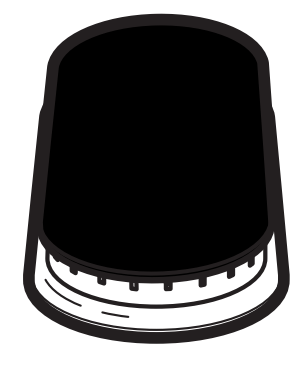
Top-of-Range Cookware
Aluminum: Medium-weight cookware is recommended because it heats quickly and evenly. Most foods brown evenly in an aluminum skillet. Use saucepans with tightfitting lids when cooking with minimum amounts of water.
Stainless Steel: This metal alone has poor heating properties and is usually combined with copper, aluminum or other metals for improved heat distribution. Combination metal skillets usually work satisfactorily if they are used with medium heat or as the manufacturer recommends.
Cast-Iron: If heated slowly, most skillets will give satisfactory results.
Enamelware: Under some conditions, the enamel of some cookware may melt. Follow the cookware manufacturer’s recommendations for cooking methods.
Glass: There are two types of glass cookware—those for oven use only and those for top-of-range cooking (saucepans, coffee and teapots). Glass conducts heat very slowly.
Heatproof Glass Ceramic: Can be used for either surface or oven cooking. It conducts heat very slowly and cools very slowly. Check the cookware manufacturer’s directions to be sure it can be used on gas ranges.
Stove Top Grills
Do not use an after-market stove top grill on your gas surface burners. A stove top grill will cause incomplete combustion resulting in carbon monoxide levels above allowable standards. This could be hazardous to your health.

Using a Wok
Use only a flat-bottomed wok with a diameter of 14 inches or less. Make sure the wok bottom sits flat on the grate. Do not use a wok support ring. Placing the ring over the burner or grate may cause the burner to work improperly, resulting in carbon monoxide levels above allowable standards. This could be hazardous to your health.
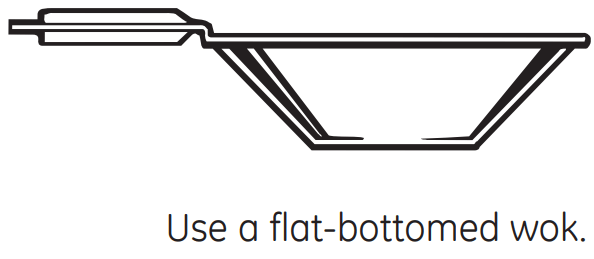
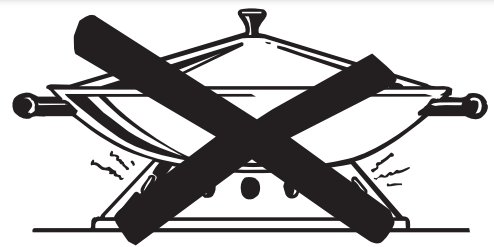
Griddle
Positioning Your Griddle
The reversible cast-iron griddle (on some models) and the nonstick aluminum griddle (on some models) can only be used over the center burner of the rangetop. To position the griddle, remove the center grate (if present), and replace it with the griddle. Do not turn on the center burner until you are certain the griddle has been positioned correctly.
Preheating Your Griddle
If your center burner is a single oval burner, preheat your griddle for 2-5 minutes on Hi before placing food on the griddle. If your center burner is a dual oval burner, preheat your griddle for 5-10 minutes on Hi before placing food on the griddle. Once the griddle is preheated, turn the heat down to the cook setting outlined in the table corresponding to your griddle. To determine the type of burner you have, see the Types of Surface Burners section.
Using Your Reversible Cast-Iron Griddle (on some models)
The ribbed side of the reversible griddle can be used for food normally grilled. Your griddle provides an extra-large cooking surface for meats, pancakes and other foods usually prepared in a skillet. Before first use, rinse with hot water and dry thoroughly. Prepare the surface with cooking spray or vegetable oil.
Griddle Precautions:
■ Do not place the griddle in a microwave oven.
■ Do not clean your griddle in the dishwasher.
■ If something has spilled under the griddle, it should be cleaned up as soon as possible to prevent “baked on” food soil.
■ Do not allow grease to accumulate under the griddle as it can be a fire hazard. Clean under the griddle with hot, soapy water as soon as it is cool.
Preseasoned Reversible Cast-Iron Griddle
Type of Food | Cook Setting |
| Bacon | Med |
| Breakfast Sausage Links | Med |
| Eggs | Lo |
| Grilled Cheese | Med-Lo |
| Hamburgers | Med-Lo |
| Pancakes | Med-Lo |
| Warming Tortillas | Lo |
Cook settings may need to be reduced if the griddle is used for an extended time.
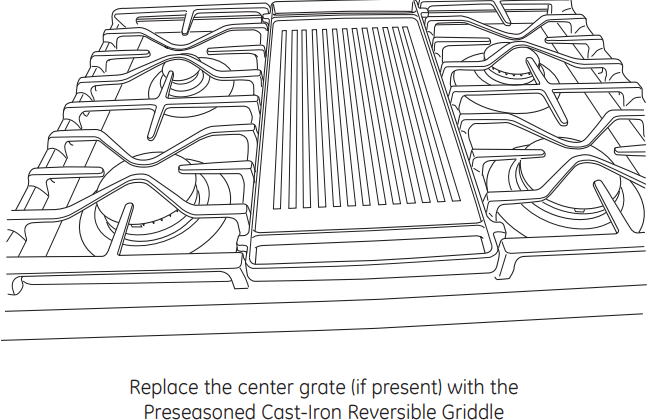
Using Your Nonstick Aluminum Griddle (on some models)
Your griddle provides an extra-large cooking surface for meats, pancakes, and other foods usually prepared in a skillet. Before first use, rinse with hot water and dry thoroughly
Griddle Precautions:
■ Do not use oil on the griddle for extended lengths of time. Permanent staining and/or craze lines on the surface could result.
■ Do not overheat the griddle. Leaving the griddle burner on at Hi for an extended amount of time without food can damage the nonstick coating.
■ Use only plastic, nylon, wooden utensils, or SilverStone® kitchen tools to prevent marring of the coating.
■ Never use knives or cut food on the griddle.
■ Do not use metal utensils with sharp points or rough, sharp edges which might damage the griddle surface.
■ Store carefully to prevent scratching.
■ Do not place the griddle in a microwave oven.
■ If something has spilled under the griddle, it should be cleaned up as soon as possible to prevent “baked on” food soil.
■ Do not allow grease to accumulate under the griddle as it can be a fire hazard. Clean under the griddle with hot, soapy water as soon as it is cool.
■ Do not clean your griddle in the dishwasher.
■ Do not clean the griddle in the self-cleaning oven. Doing so will damage the nonstick coating. For instructions on how to clean the griddle, see the Cleaning the Cooktop section of this manual.
Nonstick Aluminum Griddle
Type of Food | Cook Setting |
| Bacon | Med |
| Breakfast Sausage Links | Med |
| Fried Eggs | Lo |
| Hamburgers | Med-Hi |
| Hot Sandwiches (such as Grilled Cheese) | Med |
| Pancakes | Med-Lo |
| Warming Tortillas | Med-Lo |
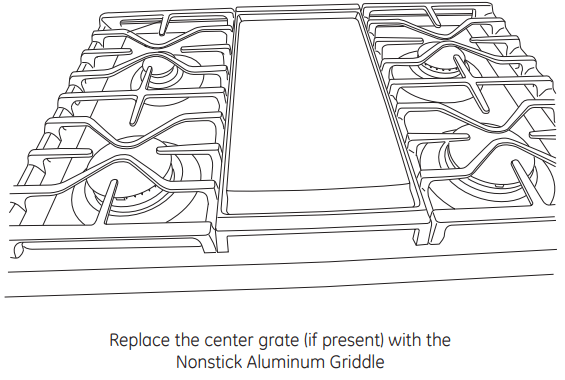
USING THE OVEN
Oven Controls
Non Convection
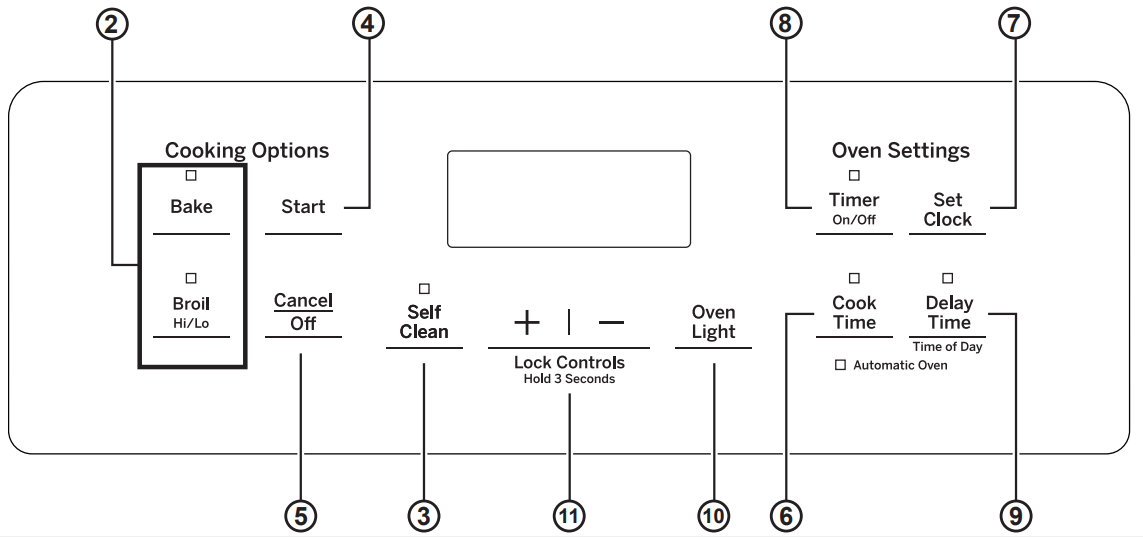
Convection
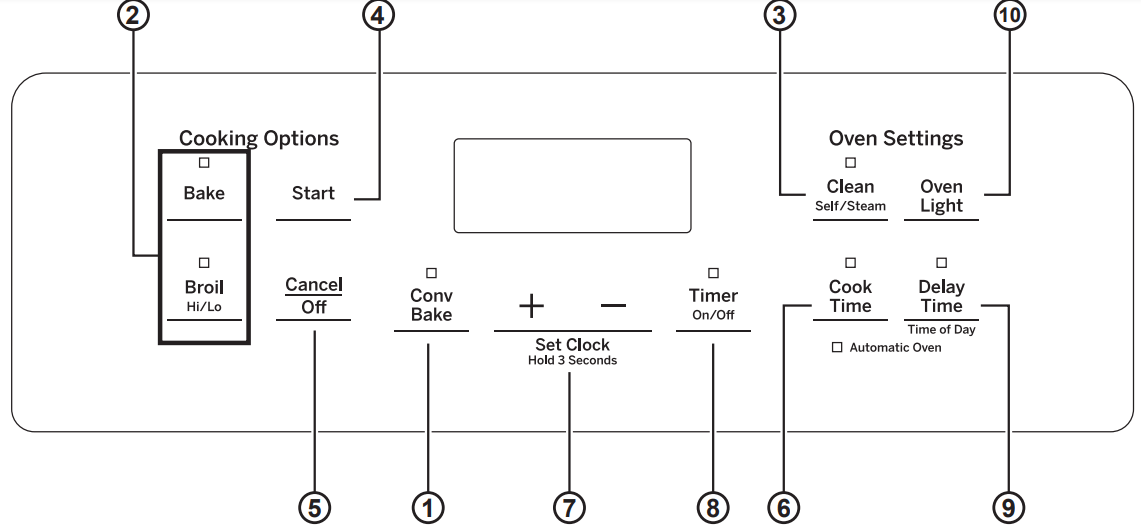
1. Convection Bake (on some models): Convection cooking uses increased air circulation to improve performance when baking on multiple racks. See the Cooking Modes section for more information.
2. Traditional Cooking Modes: Your oven has the following traditional cooking modes: Bake, Broil Hi and Broil Lo. See the Cooking Modes section for more information.
3. Clean (on some models): There are two cleaning modes: Self Clean and Steam Clean. See the Cleaning the Oven section for important information about using these modes.
4. Start: Must be pressed to start any cooking, cleaning or timed function.
5. Cancel/Off: Cancels ALL oven operations except the clock and timer.
6. Cook Time: Counts down cooking time and turns off the oven when the cooking time is complete. Program the desired cooking mode and temperature and press Start. Then, press the Cook Time pad and use the number pads to program a cooking time in hours and minutes. Then, press Start again. This can only be used with Traditional Bake and Convection Bake.
7. Clock: Sets the oven clock time and clock display (on some models). To set the clock display (on/off), press the Set Clock pad (on some models) once. If your model does not have a Set Clock pad, see the Special Features section for instructions on how to adjust the clock display. To set the clock time, press both the + and - pads and hold for 3 seconds or press the Set Clock pad until the display is flashing. Use the + and - pads to adjust the clock. Press Start to save the time.
8. Timer: Works as a countdown timer. Press the Timer pad and the + and - pads to program the time in hours and minutes. Press the Start pad. The oven will continue to operate when the timer countdown is complete. To turn the timer off, press the Timer pad.
9. Delay Time: Delays when the oven will turn on. Use this to set a time when you want the oven to start. Press the Delay Time pad, and use the + and - pads to program the time of day for the oven to turn on. Then press the desired cooking mode pad, use the + and - pads to adjust the temperature, then press Start. After Start has been pressed, a cook time may also be programmed if desired. Once the Delay Time has been programmed, the start time set for the oven will be displayed until that time is reached. Then, either the cook time (if programmed) or the temperature will be displayed. Delay Time can only be used with Traditional Bake, Convection Bake, and the Clean modes (on some models). NOTE: When using the delay time feature, foods that spoil easily—such as milk, eggs, fish, stuffings, poultry, and pork—should not be allowed to sit at room temperature for more than 1 hour before or after cooking, as this may promote the growth of harmful bacteria. Be sure that the oven light is off, because heat from the bulb will speed harmful bacteria growth.
10. Oven Light (on some models): Turns the oven light on or off.
11. Lock Controls (on some models): Locks out the control so that pressing the pads does not activate the controls. Press and both the + and - pads and hold for 3 seconds to lock or unlock the control. Cancel/Off is always active, even when the control is locked.
Oven Air Vents
Never block the vents (air openings) of the range. They provide the air inlet and outlet that are necessary for the range to keep cool and operate properly with correct combustion. Air openings are located at the rear of the cooktop, at the top and bottom of the oven door, and at the bottom of the range.
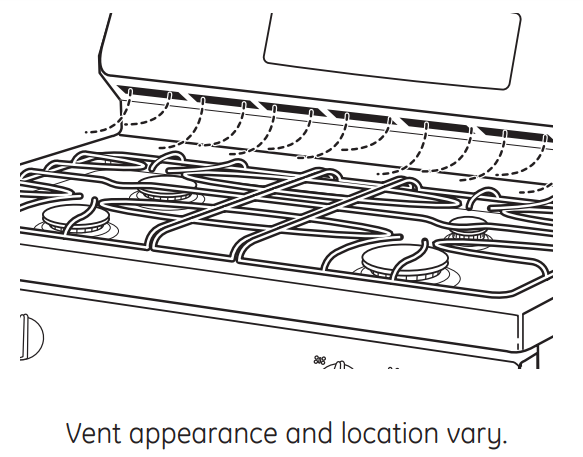
Special Features
There are several different special features on your range. To change the settings of these special features:
■ Press the Bake and Broil pads at the same time and hold for three seconds.
■ “SF” will appear in the display.
■ For instructions on how to select different features, refer to the section below that corresponds to the special feature of interest.
■ When the change has been made, press the Start key to save the change and exit the special features menu.
Adjust the Oven Temperature
This feature allows the oven baking temperature to be adjusted up to 35ºF (1.6°C) hotter or down to 35ºF (1.6°C) cooler. Use this feature if you believe your oven temperature is too hot or too cold and wish to change it. This adjustment affects every cooking mode except broil. After entering the special features menu, press the Bake pad to enter the temperature adjustment mode. A number between 35 and - 35 will display. Use the + or - pads to set the desired temperature adjustment. Press the Start pad to save the temperature adjustment.
12-Hour Auto Shut-Off and Sabbath
12-hour auto shut-off turns off the oven after 12 hours of continuous operation. The 12-hour auto shut-off may be “on” or “oFF.” For details on the “sAb” option, see the Sabbath Mode Section. Enter into the special features menu as outlined above and repeatedly press the Set Clock pad until the desired setting is displayed. If your model does not have a Set Clock pad, then repeatedly press the Cook Time pad until the desired setting is displayed. Press the Start pad to save the setting.
Clock Display (on some models)
This feature specifies if the time of day is displayed. The clock display may be “on” or “oFF.” If your model has a Set Clock pad, see the Oven Controls section for instructions on adjusting the display. If your model does not have a Set Clock pad, enter into the special features menu as outlined above. Press the Timer pad to see the current setting. Press the Timer pad again to change the setting. Press the Start pad to save the display setting.
Increment/Decrement Speed
A setting (i.e. temperature) may be rapidly adjusted by pressing and holding the + or - pad. To adjust the increment/decrement speed, enter into the special features menu as outlined above. Press the + pad to increase the speed or press the - pad to decrease the speed. Settings vary from 1 (slowest) to 5 (fastest). Press the Start pad to save the speed setting.
Sabbath Mode
The Sabbath mode feature complies with standards set forth by Star K. Only continuous baking or timed baking is allowed in the Sabbath mode. All tones are disabled in the Sabbath mode; however the oven light is not disabled, so the light should be removed to ensure it does not come on when the door is opened. Cooking in the Sabbath mode is a two-step process, first the Sabbath mode must be set and then the bake mode must be set.
Setting the Sabbath Mode
Press the Bake and Broil pads at the same time and hold for three seconds. “SF” will appear in the display. Press the Set Clock pad until “SAb” appears in the display and then press Start. If your model does not have a Set Clock pad, then press the Cook Time pad until “SAb” appears in the display and then press Start. A single bracket “]” will appear in the display indicating that the Sabbath mode is set. Continuous bake or timed bake can now be set as outlined below.
Start a Continuous Bake
Press Bake, if a temperature other than 350°F (176.7°C) is desired then press the + or - pads to adjust the temperature in 25 degree (14°C) increments, then press Start. After a delay, a second bracket “] [” will appear in the display indicating that the oven is baking.
Adjusting the Temperature Press Bake, then press the + or - pads to adjust the temperature in 25 degree (14°C) increments, then press Start. An oven thermometer can be used if some indication of temperature setting is desired.
Start a Timed Bake
Press Cook Time, then press the + or - pads to adjust the cook time in one minute increments. Press Bake, if a temperature other than 350°F (176.7°C) is desired then press the + or - pads to adjust the temperature in 25 degree (14°C) increments, then press Start. After a delay, a second bracket “] [” will appear in the display indicating that the oven is baking. When the cook time expires the display will change back to a single bracket “]” indicating that the oven is no longer baking.
Exit the Sabbath Mode
Exiting the Sabbath mode should be done after the Sabbath is over. Press Cancel/Off to end any bake mode that may be running. Press Bake and Broil pads at the same time and hold for three seconds. “SF” will appear in the display. Press the Set Clock pad until “On” appears in the display and then press Start. If your model does not have a Set Clock pad, then press the Cook Time pad until “On” appears in the display and then press Start. The display will change from a single bracket “]” to the time of day indicating that the Sabbath mode has been exited.
Sabbath Mode Power Outage Note
If a power outage occurs, the Sabbath mode will not resume when power is restored.
Cooking Modes
Your new oven has a variety of cooking modes to help you get the best results. These modes are described below. Refer to the Cooking Guide section for recommendations for specific foods. Remember, your new oven may perform differently than the oven it is replacing. NOTE: Remove unused racks from oven and/or broil drawer for faster preheat, improved efficiency, and optimal performance.
Bake
The bake mode is for baking and roasting. This mode uses heat only from the lower burner. When preparing baked goods such as cakes, cookies and pastries, always preheat the oven before inserting food. Follow recipe recommendations for food placement. If no guidelines are provided, center food in the oven. To use this mode, press the Bake pad, use the + and - pads to adjust the temperature, then press Start.
Broiling Modes
Always broil with the oven door and drawer closed. Monitor food closely while broiling. Use caution when broiling on the upper rack positions as placing food closer to the broil burner increases smoking, spattering, and the possibility of fats igniting. Try broiling foods that you would normally grill. Adjust rack positions to adjust the intensity of the heat to the food. Place foods closer to the broil burner when a seared surface and rare interior is desired. Thicker foods and foods that need to be cooked through should be broiled on a lower rack position or by using the Broil Lo mode.
Broil Hi
The Broil Hi mode uses intense heat from the upper burner to sear foods. Use Broil Hi for thinner cuts of meat and/or foods you prefer less done on the interior. To use this mode press the Broil pad once and then press Start. It is not necessary to preheat when using this mode.
Broil Lo
The Broil Lo mode uses less intense heat from the upper burner to cook food thoroughly while also browning the surface. Use Broil Lo for thicker cuts of meat and/or foods that you would like cooked all the way through. To use this mode press the Broil pad twice and then press Start. It is not necessary to preheat when using this mode.
Convection Bake (on some models)
The Convection Bake mode is intended for baking on multiple racks at the same time. This mode uses air movement from the convection fan to enhance cooking evenness. Your oven is equipped with Auto Recipe Conversion, so it is not necessary to adjust the temperature when using this mode. To use this mode press the Conv Bake pad, use the + and - pads to adjust the temperature, and then press Start. Always preheat when using this mode.
Cookware Guidelines
The material, finish and size of cookware affect baking performance. Dark, coated and dull pans absorb heat more readily than light, shiny pans. Pans that absorb heat more readily can result in a browner, crisper and thicker crust. If using dark and coated cookware check food earlier than the minimum cook time. If undesirable results are obtained with this type of cookware consider reducing oven temperature by 25ºF (14°C) next time.
■ Shiny pans can produce more evenly cooked baked goods such as cakes and cookies.
■ Glass and ceramic pans heat slowly but retain heat well. These types of pans work well for dishes such as pies and custards.
■ Air insulated pans heat slowly and can reduce bottom browning.
■ Keep cookware clean to promote even heating.
Aluminum Foil and Oven Liners
Foil may be used to catch spills by placing a sheet on a lower rack, several inches below the food. Do not use more foil than necessary and never entirely cover an oven rack with aluminum foil. Keep foil at least 1-1/2” (3.8 cm) from oven walls to prevent poor heat circulation.
Oven Racks
Rack Positions
Your oven has six rack positions in the main oven. Recommended rack positions for various types of foods are provided in the Cooking Guide. Adjusting the rack position is one way to impact cooking results. For example, if you would prefer darker tops on cakes, muffins or cookies, try moving food one rack position higher. If you find foods are too brown on top, try moving them down next time. When baking with multiple pans and on multiple racks, ensure there is sufficient space between pans to allow air to flow. This may improve cooking evenness.
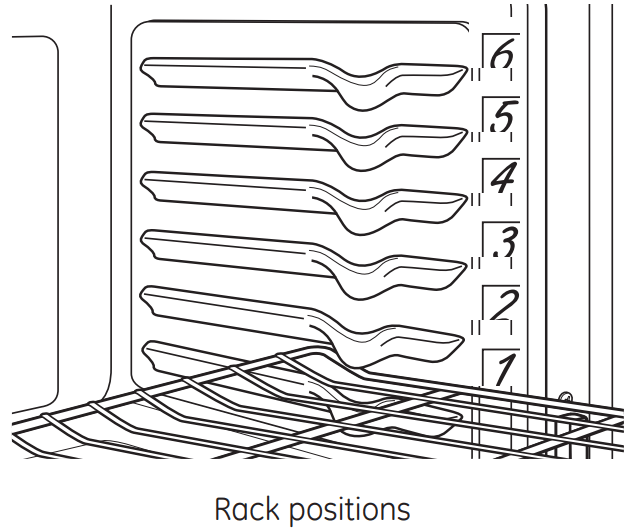

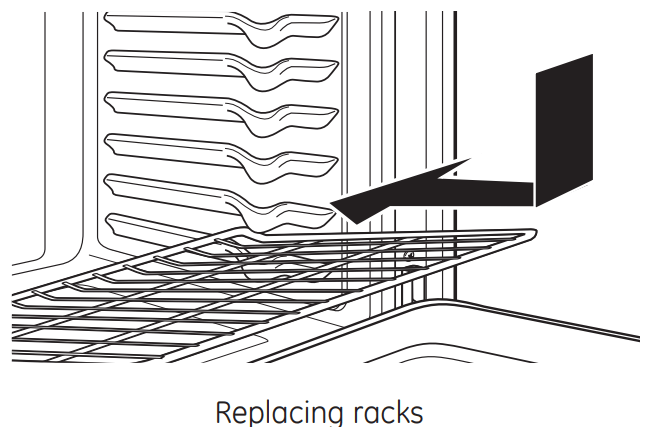
Removing and Replacing
Racks When placing and removing cookware, pull the rack out to the bump (stop position) on the rack support. To remove a rack, pull it toward you until it reaches the stop position, tilt up the front of the rack and pull it out. To replace a rack, place the curved end of the rack onto the rack supports. Tilt up the front of the rack and push the rack in until it stops. Then lay the rack flat and push it in until it is all the way into the oven. Racks may become difficult to slide, especially after a self-clean cycle. To improve sliding conditions, use a soft cloth or paper towel to rub vegetable oil on the left and right edges of the racks and/or rack supports. NOTE: Remove unused racks when using the oven for faster preheat, improved efficiency and optimal cooking performance. See the Assistance/Accessories section for instructions on ordering additional racks.
Broil Drawer (on some models)
For better searing use the rack position that places food closest to the broil heater. Move food down or use Broil Lo mode for more doneness/less searing. In positions B and C, the broil pan (some models) or rack (some models) rests on the drawer side supports. In the bottom position (A), cookware sits directly on the drawer bottom. Take care not to touch the inner door when placing and removing food on the drawer bottom.
When placing cookware on the rack or drawer bottom, use front-to-back orientation for easier placement and better coverage.
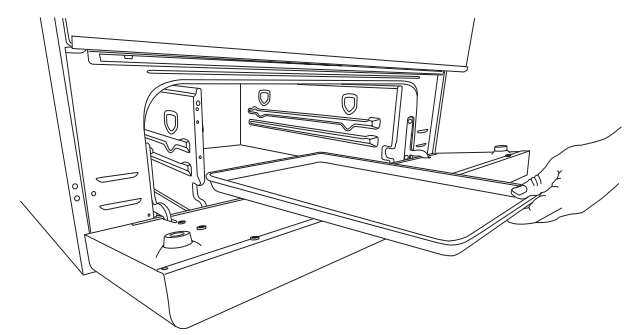
Drop-down Slide-out Broil Drawer (on some models)
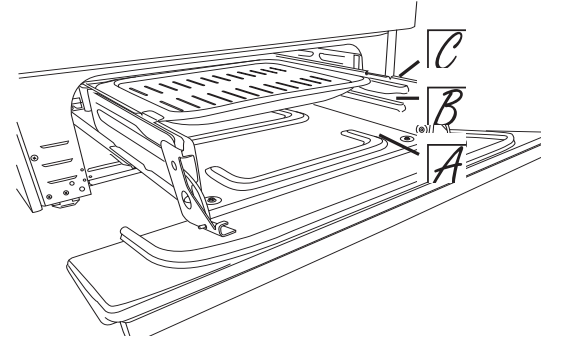
Drop-down Broil Drawer (some models)
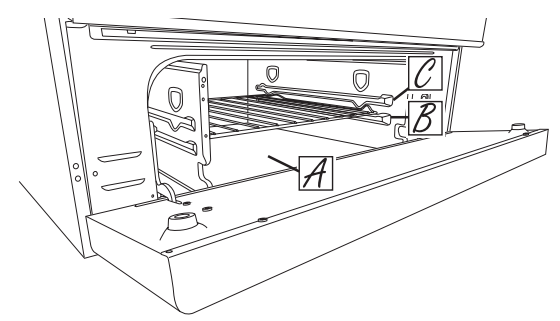
Cooking Guide
FOOD TYPE | RECOMMENDED MODE(S) | RECOMMENDED RACK POSITION(S) | ADDITIONAL SUGGESTIONS |
| Baked Goods | |||
| Layer cakes, sheet cakes, bundt cakes, muffins, quick breads, biscuits, scones on a Single Rack | Bake | 4 or 5 | Use shiny cookware. |
| Layer cakes* on Multiple Racks | Bake Convection Bake | 3 and 5 | Ensure adequate airflow (see illustration below). |
| Chiffon cakes (angel food) | Bake | 2 | Use shiny cookware. |
| Cookies, biscuits, scones on a Single Rack | Bake | 3 or 4 | Use shiny cookware. |
| Cookies, biscuits, scones on Multiple Racks | Convection Bake Bake | 2 Racks - 3 and 5 3 Racks - 2, 4 and 6 | Ensure adequate airflow. Switch food location partially through cooking for more even cooking results |
| Beef & Pork | |||
| Hamburgers | Broil Hi | 6 or C | Use a broil pan; move food down for more doneness/less searing. Watch food closely when broiling. Center food under burner |
| Steaks & Chops | Broil Hi | 6 or C | Use a broil pan; move food down for more doneness/less searing. Watch food closely when broiling. Center food under burner |
| Roasts | Bake | 2 or 3 | Leave uncovered, use a low sided pan such as a broil pan. Preheating is not necessary. |
| Poultry | |||
| Whole chicken | Bake | 2 or 3 | Leave uncovered, use a low sided pan such as a broil pan. |
| Bone-in chicken breasts, legs, thighs | Broil Lo Bake | 4 or B | If breaded or coated in sauce avoid Broil Hi modes. Broil skin side down first. Watch food closely when broiling. |
| Boneless chicken breasts | Broil Lo Bake | 4 or B | Move food down for more doneness/less searing and up for greater searing/browning when broiling. |
| Whole turkey | Bake | 1 or 2 | Leave uncovered, use a low sided pan such as a broil pan |
| Turkey Breast | Bake | 2 or 3 | Leave uncovered, use a low sided pan such as a broil pan. |
| Fish | Broil Lo | 6 or C (1/2”/13 mm thick or less) 5 or B (>1/2”/13 mm) | Watch food closely when broiling. |
| Casseroles | Bake | 3 or 4 | |
| Frozen Convenience Foods | |||
| Pizza, potato products, chicken nuggets, appetizers on a Single Rack | Bake | 4 or 5 | Use shiny cookware. |
| Pizza, potato products, chicken nuggets, appetizers on Multiple Racks | Bake Convection Bake | 3 and 5 2, 4 and 6 | Use shiny cookware. Switch food location partially through cooking for more even cooking results. |
*When baking four cake layers at a time, stagger the pans as shown to the right so that one pan is not directly above another.
Cook food thoroughly to help protect against foodborne illness. Minimum safe food temperature recommendations for food safety can be found at page. Make sure to use a food thermometer to take food temperatures.
NOTE: Remove unused racks when using the oven for faster preheat, improved efficiency and optimal cooking performance.
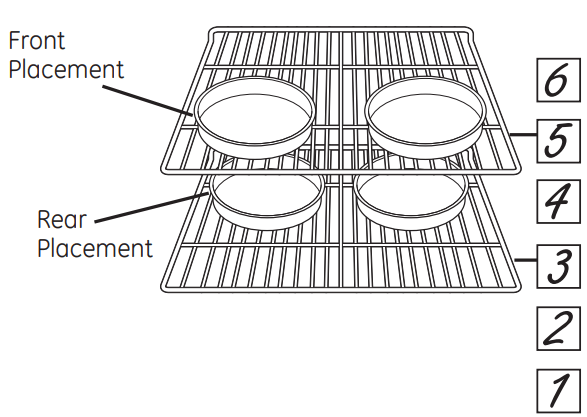
CARE AND CLEANING
Cleaning the Oven
Oven Interior
The interior of your new oven can be cleaned manually or by using the Steam Clean or Self Clean modes (on some models). Spillage of marinades, fruit juices, tomato sauces and basting liquids containing acids may cause discoloration and should be wiped up as soon as hot surfaces cool, then clean and rinse.
Manual Cleaning
Do not use oven cleaners, strong liquid cleansers, steel wool, or scouring pads on the interior of the oven. For soils on the oven bottom and other enameled surfaces, use a gentle abrasive containing oxalic acid, such as Bar Keepers Friend®, with a non-scratch sponge. Take care not to apply any abrasive cleaners or sponges to the door glass, as it will scratch the reflective coating. The oven interior and door glass may be cleaned using a soft cloth with a mild soap and water, or vinegar and water solution. After cleaning, rinse with clean water and dry with a soft cloth.
Steam Clean Mode (on some models)
The range should be at room temperature before beginning the Steam Clean cycle. If the oven is too hot, “Hot” will appear on the display and the cycle will not activate until the oven cools down. The Steam Clean feature is for cleaning light soil from your oven at a lower temperature than Self Clean.
To use the Steam Clean feature:
1. Start with the oven at room temperature.
2. Wipe excess grease and soils from the oven.
3. Pour one cup of water onto the bottom of the oven.
4. Close and latch the door (on some models).
5. Press the Clean pad twice and then press Start.
Do not open the door during the 30 minute Steam Clean cycle as it will reduce the cleaning performance. At the end of the Steam Clean cycle, unlatch and/or open the door, soak up the remaining water, and wipe the moisture-softened soil from the oven walls and door. See instructions in Manual Cleaning for any remaining soils.
Self Clean Mode (on some models)
Read the Self-Cleaning Oven Safety Instructions at the beginning of this manual before using Self Clean Mode. Self clean uses very high temperatures to clean the oven interior. For a moderately soiled oven, run a 3 hour self clean cycle. For a heavily soiled oven, run a 5 hour self-clean cycle. Only self-clean (black) racks and grates may remain in the oven during the self-clean cycle. All other items, including nickel plated (silver) racks, should be removed. If nickel plated racks are left in the oven during a self-clean cycle, the racks will tarnish. If either type of rack is left in the oven during a self-clean cycle, the rack may become difficult to slide. See the Oven Racks section for lubrication instructions.
IMPORTANT: The health of some birds is extremely sensitive to the fumes given off during the self-cleaning cycle of any range. Move birds to another wellventilated room. To use the Self Clean feature:
1. Start with the oven at room temperature.
2. Wipe excess grease and soils from the oven and interior door.
3. Remove all items other than self-clean (black) racks and grates, if desired. See Cleaning the Cooktop to determine if your grates may be selfcleaned and for important details regarding grate placement.
4. Close and latch the door
5. Press the Clean pad once and set a time between 3 and 5 hours, and then press Start.
You cannot open the door during the self-clean cycle. If the oven is too hot, you will not be able to slide the latch. At the end of the self-clean cycle, allow the oven to cool, unlatch the door and wipe any ash out of the oven.
Oven Exterior
Do not use oven cleaners, abrasive cleansers, strong liquid cleansers, steel wool, plastic scouring pads or cleaning powders on the interior or exterior of the oven. Clean with mild soap and water or a 50/50 solution of vinegar and water. Rinse with clean water and dry with a soft cloth. When cleaning surfaces, make sure that they are at room temperature and not in direct sunlight. Spillage of marinades, fruit juices, tomato sauces and basting liquids containing acids may cause discoloration and should be wiped up as soon as hot surfaces cool, then clean and rinse.
Oven Racks
All oven racks may be cleaned by hand with an abrasive cleaner or steel wool. Self-clean (black) oven racks may remain in the oven during the self-clean cycle. Nickelplated (silver) racks should not remain in the oven during the self clean cycle. Doing so will tarnish the racks. If either type of rack is left in the oven during a self-clean cycle, the rack may become difficult to slide. After cleaning the racks, use a soft cloth or paper towel to rub a small amount of vegetable oil on the left and right edges of the rack. This will ensure the racks are easy to slide in and out of the oven
Cleaning the Cooktop
Control Panel and Knobs
Wipe the control panel after each use of the oven with a damp cloth. For cleaning, use mild soap and water or a 50/50 solution of vinegar and water. Rinse with clean water. Polish dry with a soft cloth. Do not use abrasive cleansers, strong liquid cleansers, plastic scouring pads or oven cleaners on the control panel—they will damage the finish.
Stainless Steel Surfaces (on some models)
Do not use a steel wool pad; it will scratch the surface. To clean the stainless steel surface, use warm sudsy water or a stainless steel cleaner or polish. Always wipe the surface in the direction of the grain. Follow the cleaner instructions for cleaning the stainless steel surface. Cleaners with oxalic acid such as Bar Keepers Friend Soft Cleanser™ will remove surface rust, tarnish and small blemishes. Use only a liquid cleanser free of grit and rub in the direction of the brush lines with a damp, soft sponge.
To inquire about purchasing cleaning products including stainless steel appliance cleaner or polish, read the Assistance/Accessories sections at the beginning of this manual. For easier cleaning, the control knobs may be removed by pulling them directly outwards once the knobs are in the OFF position. Do not pull knobs up or down or hang objects on them. This can damage the gas valve shaft. The knobs can be washed by hand with soap and water or in a dishwasher. To replace knobs after cleaning, align the hole on the knob backside with the gas valve shaft and push inward until the knob is securely fastened. All knobs are interchangeable
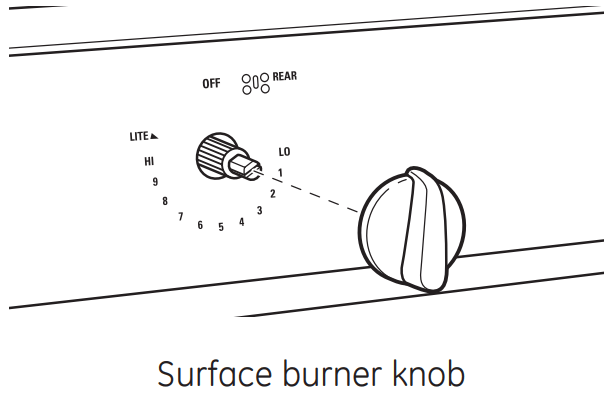
Cooktop Surface
Do not use oven cleaners, abrasive cleansers, strong liquid cleansers, steel wool, plastic scouring pads, or cleaning powders on the cooktop surface. Clean with a mild soap and water or a 50/50 solution of vinegar and water. Rinse with clean water and dry with a soft cloth. When cleaning surfaces, make sure that they are at room temperature and not in direct sunlight. Spillage of marinades, fruit juices, tomato sauces and basting liquids containing acids may cause discoloration and should be wiped up as soon as hot surfaces cool, then clean and rinse. If your model has a stainless steel cooktop surface, refer to the Stainless Steel Surface cleaning instructions featured in the Control Panel and Knobs section.
Cleaning the Surface Burners
Turn all controls off. Allow the cooktop to cool before removing grates and burner parts. When removing the burner caps and heads, remember their size and location. Replace them in the same location after cleaning.
Removing Surface Burners
CAUTION : Do not attempt to remove oval burner cap from burner head.
Round Burner
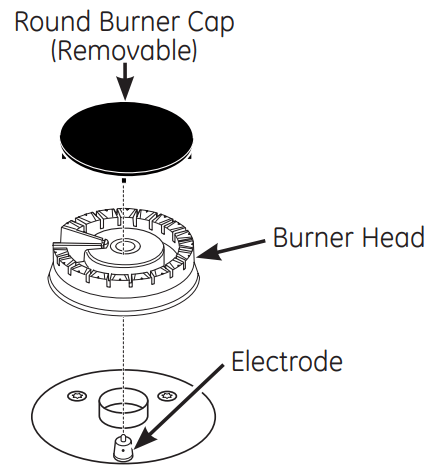
Oval Burner (on some models)
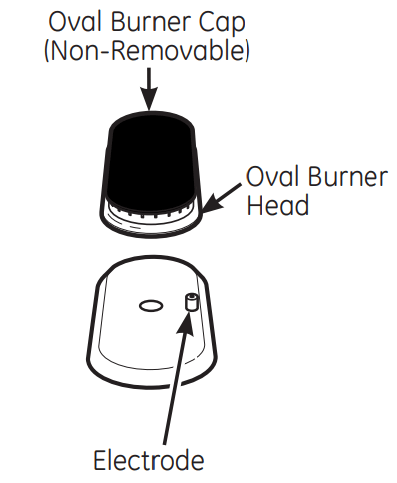
Cleaning the Burner Caps
Wash burner caps in hot, soapy water and rinse with clean water. You may scour with a plastic scouring pad to remove burned-on food particles. The round burner caps may also be cleaned in your dishwasher.
Cleaning the Burner Heads
Wash the burner heads routinely, especially after bad spillovers which could clog the burner openings. Lift burners off when cool. Wash with hot, soapy water. Rinse with clean water. For more stubborn stains, use a brush with plastic bristles.
NOTE: Do not use steel wool or scouring pads to clean the burner parts as these may clog the openings. Never wash burner heads in your dishwasher. Doing so may cause them to discolor. The ports in the burner heads must be kept clean at all times for an even, unhampered flame. Clogged or dirty burner ports or electrodes will not allow the burner to operate properly
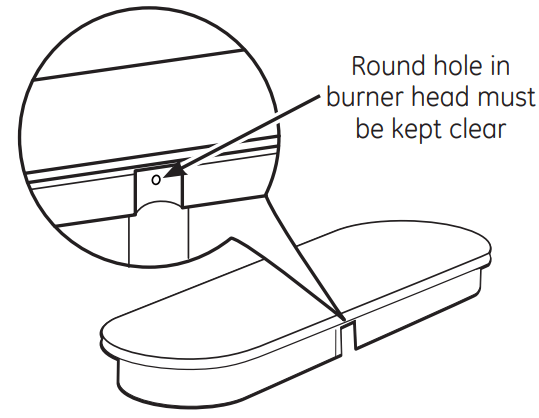
For proper ignition, make sure the small hole in the notch that fits over the electrode is kept open. A sewing needle or wire twist-tie works well to unclog it.
Replacing Surface Burners
Before replacing the burner caps, heads and oval head/ cap assembly, shake out excess water and allow them to dry thoroughly. Replace burner heads in the correct locations according to size. Ensure each cap is properly seated on the burner head, as pictured below.
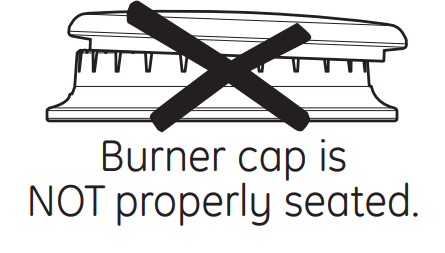
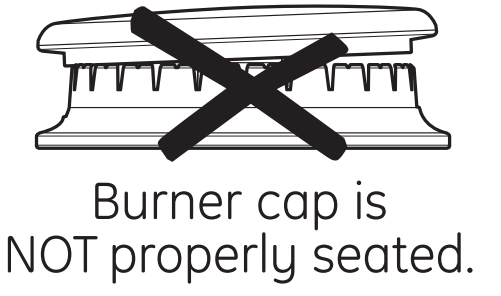
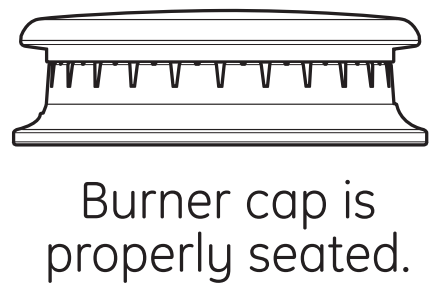
Burner Grates
Manual Cleaning
Grates should be washed in hot, soapy water and rinsed with clean water or in the dishwasher. To soften burned-on food, place grates in a solution containing ¼-cup of household ammonia for several hours. Afterward, scrub grates with a plastic scouring pad soaked in hot, soapy water. Rinse well and dry.
Self Clean Mode (on some models)
If your grates do not have rubber bumpers on their bottom surface, they may be cleaned in the oven using the self-clean cycle. Do not attempt to clean your grates in the oven if your grates have rubber bumpers. Doing so will destroy the rubber bumpers and may affect the function of your surface burners. Porcelain-coated grates may gradually dull if continually exposed to self-clean temperatures. If your oven is equipped with self-clean (black) racks, it is recommended to follow the instructions for placing grates on racks. If your oven is equipped with nickelplated (silver) racks, it is recommended to follow the instructions for placing grates on the oven bottom. Nickel-plated racks should not remain in the oven during the self clean cycle. Doing so will tarnish the racks. If either type of rack is left in the oven during a self-clean cycle, the rack may become difficult to slide. See the Oven Rack section for lubrication instructions.
NOTE: When placing or removing grates from the oven, do not slide the grates on the racks or oven bottom. Doing so could damage the enamel on the racks or oven bottom.
To self-clean your grates on self-clean racks:
1. Insert racks in positions 1, 3, and 5 or positions 2 and 4.
2. Gently place one grate on each rack.
To self clean your grates on the oven bottom:
1. Remove all oven racks.
2. Gently place one grate on the center of the oven bottom with the grate oriented in the upright position. Stack remaining grate(s) as shown below. Do not place or stack grates in any other configuration.
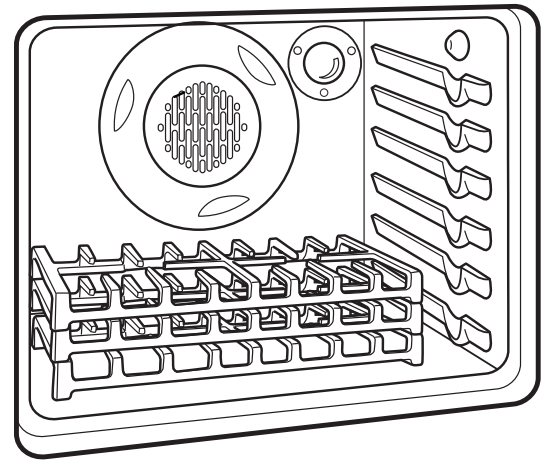
Once the grates are placed in the oven, operate the self-clean cycle per the instruction in the Cleaning the Oven section.
NOTE: Use caution when removing the grates from the oven after the self-clean cycle has ended. The grates may still be hot. Once the self-clean cycle is complete, the grates may carefully be removed. You may notice a white residue on the grates. Wipe it off with a damp sponge. If white spots persist, wet the sponge with a 50/50 solution of vinegar and water and wipe the grates again. When replacing the grates on the cooktop, be sure to locate them correctly. Grates should fit securely into the cooktop.
Grate Support Bumpers (on some models)
If any of the rubber grate support bumpers in the cooktop are missing or damaged, replacement parts can be obtained by calling 1.800.GE.CARES. To insert the new bumpers, simply place the cone-shaped end of the bumper into the hole in the cooktop and push down while gently twisting the bumper.
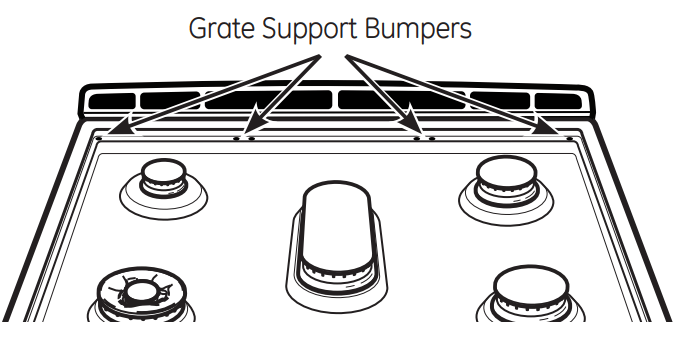
Griddles (on some models)
Nonstick Aluminum Griddle: Avoid scraping the griddle surface with metal utensils. Wash your griddle with dish soap and hot water. If necessary, scrub with a nonabrasive plastic pad.
Reversible Cast-Iron: Clean your reversible cast-iron griddle with a stiff brush and hot water. Using soap is not recommended, and harsh detergents should never be used as they will remove the seasoning. Rinse with hot water and dry thoroughly. After rinsing, preseason the griddle by applying a light coat of cooking oil to the griddle surface. Wipe off excess oil with a paper towel. Store in a cool, dry place.
Griddle Precautions:
■ If something has spilled under the griddle, it should be cleaned up as soon as possible to prevent the spill from getting baked onto the cooktop.
■ Do not allow grease to accumulate under the griddle as it can be a fire hazard. Clean under the griddle with hot, soapy water as soon as it is cool.
■ Do not wash your griddle in the dishwasher.
■ Do not clean the griddle in the self-cleaning oven.
Cleaning the Door and Drawer
Cleaning the Oven Door
Cleaning the Door Interior
Do not allow excess water to run into any holes or slots in the door. Wipe dish soap over any baked-on spatters on the glass. Use a non-scratch sponge to clean it off. Then wipe over the glass with a soapy cloth to remove any residue and dry off. The area outside the gasket can be cleaned with a soap-filled non-scratch sponge. Do not rub or clean the door gasket - it has an extremely low resistance to abrasion. If you notice the gasket becoming worn, frayed or damaged in any way or if it has become displaced on the door, you should have it replaced.
Cleaning the Door Exterior
If a stain on the door vent trim is persistent, use a mild abrasive cleaner and a sponge-scrubber for best results. Do not use this method on any other surface.
Stainless Steel Surfaces (on some models)
Do not use a steel wool pad; it will scratch the surface. To clean the stainless steel surface, use warm sudsy water or a stainless steel cleaner or polish. Always wipe the surface in the direction of the grain. Follow the cleaner instructions for cleaning the stainless steel surface. Cleaners with oxalic acid such as Bar Keepers Friend Soft Cleanser™ will remove surface rust, tarnish and small blemishes. Use only a liquid cleanser free of grit and rub in the direction of the brush lines with a damp, soft sponge. To inquire about purchasing cleaning products including stainless steel appliance cleaner or polish, read the Assistance/Accessories sections at the beginning of this manual.
Removable Storage Drawer (on some models)
The storage drawer is a good place to store cookware and bakeware. Do not store plastics or flammable material in the drawer. The storage drawer may be removed for cleaning under the range. Clean the storage drawer with a damp cloth or sponge. Never use harsh abrasives or scouring pads.
Removing the Storage Drawer:
1. Pull drawer straight out until it stops.
2. Tilt the front of the drawer upward and pull the drawer free of the range.
Replacing the Storage Drawer:
1. Rest the drawer slides on the range stops.
2. Push directly backward until the drawer drops into place.
3. Slide the drawer all the way into the oven.
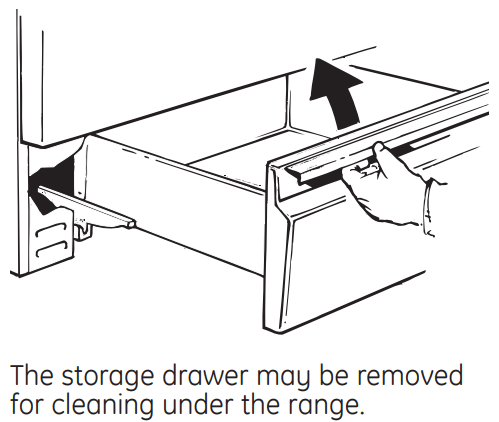
Removable Broil Drawer (on some models)
Most cleaning can be done with the drawer in place. However, the drawer may be removed if further cleaning is needed. Use soap and warm water to thoroughly clean
Removing the Broil Drawer:
1. When the broiler is cool, remove the grid and pan.
2. Pull the broil drawer out until it stops, then push it back in about one inch.
3. Grasp the handle, lift and pull the broiler drawer out. Clean the broiler drawer with hot soapy water.
Replacing the Broil Drawer:
1. Hold the broil drawer in the raised position as you slide it partway into the range.
2. Lower the drawer and push it completely closed.
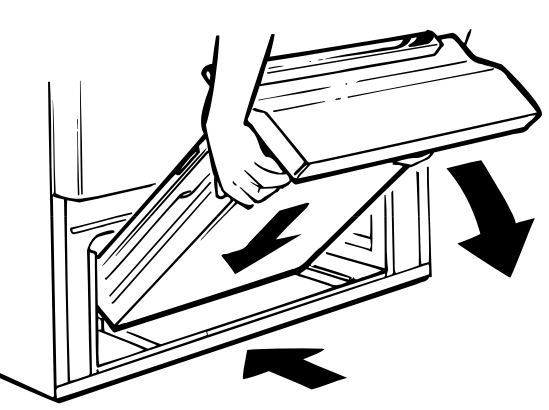
Maintenance
Oven Light
Replacing the Light Bulb:
1. Disconnect electrical power to the range.
2. Hold the glass cover stable, so it doesn’t fall when released.
3. Slide near the indent of the cover holder until the cover is released. Do not remove any screws to release the glass cover.
4. Replace bulb with a 40-watt household appliance bulb. Do not touch hot bulb with hand or wet cloth. Only remove bulb when it is cool.
5. Hold glass cover stable over new bulb.
6. Pull the wire cover holder near the indent until the indent in the wire cover holder is located in the indent of the glass cover.
7. Connect electrical power to range.
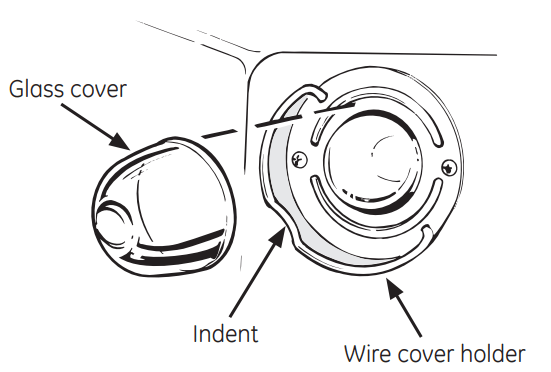
Lift-Off Oven Door
The door is very heavy. Be careful when removing and lifting the door. Do not lift the door by the handle.
Removing the Door:
1. Fully open the oven door.
2. On each hinge, slide the hinge lock up, making sure it snaps into its fully raised position.
3. Firmly grasp both sides of the door near the handle.
4. Close the door until the top of the door is approximately 3” (8 cm) from the range frame.
5. Lift door up and away from the range until both hinge arms are clear of the slots in the range frame.
Replacing the Door:
1. Firmly grasp both sides of the door near the handle.
2. With the door at the same angle as the removal position, rest the notch in the bottom of the left hinge arm on the bottom edge of the left hinge slot. The notch in the hinge arm must be fully seated onto the bottom of the slot. Repeat for the right side.
3. Fully open the door. If the door will not fully open, the hinge arms are not seated correctly. Lift the door off the range and repeat Step 2.
4. Push the hinge locks down to the locked position.
5. Close the oven door.
Pull hinge locks up to unlock

Removal position
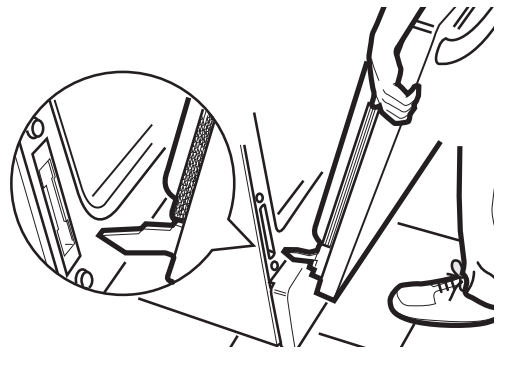
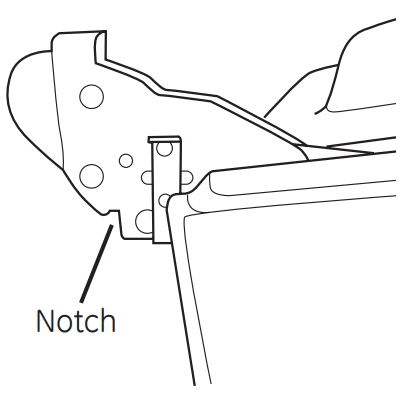
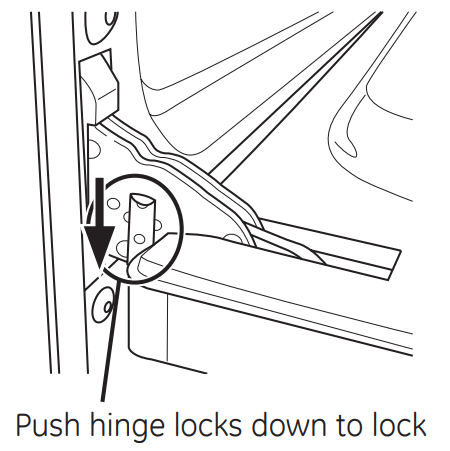
Troubleshooting tips
Problem | Possible Cause | What To Do |
| My new oven doesn't cook like my old one. | Your new oven has a different cooking system from your old oven and therefore may cook differently than your old oven. | For the first few uses, follow your recipe times and temperatures carefully and use rack positions recommended in the Cooking Guide. If you still think your new oven is too hot or too cold, you can adjust the temperature yourself to meet your specific cooking preference. See the Special Features section. |
| Food does not bake properly | Oven controls improperly set. | See the Cooking Modes section |
| Rack position is incorrect. | See the Cooking Guide. | |
| Rack is not level. | See the Installation Instructions for directions on leveling your range. | |
| Incorrect cookware or cookware of improper size being used. | See the Cookware section. | |
| Oven temperature needs adjustment | See the Special Features section. | |
| Food does not broil properly | Oven controls improperly set. | Make sure you select the appropriate broil mode. See the Cooking Guide. |
| Improper rack position being used. | See Cooking Guide for rack position suggestions. | |
| Cookware not suited for broiling. | Use a pan specifically designed for broiling. | |
| Aluminum foil on the broil pan has not been fitted properly or slit to drain grease. | If using aluminum foil on broil pan, wrap tightly and add slits conforming to those in the pan to allow grease to drain. | |
| Oven temperature too hot or too cold | Oven temperature needs adjustment. | See the Special Features section. |
| Oven and/or display appears not to work | A fuse in your home may be blown or the circuit breaker tripped. | Replace the fuse or reset the circuit breaker. |
| Oven controls improperly set. | See the Using the Oven section | |
| Oven is in Sabbath Mode. | Verify, that the oven is not in Sabbath Mode. See the Special Features section. | |
| The clock is turned off. | See the Oven Controls or Special Features section. | |
| “Crackling” or “popping” sound | This is the sound of the metal heating and cooling during both the cooking and cleaning functions. | This is normal. |
| Range is making a “clicking” noise when using my oven. | Your range has been designed to maintain a tighter control over your oven's temperature. You may hear your oven's heating elements "click" on and off more frequently than in older ovens to achieve better results during baking, broiling, and self-clean cycles. | This is normal. |
| Sometimes the oven takes longer to preheat to the same temperature | Cookware, food, and/or number of racks in oven. | Cookware, food, and racks in the oven will cause differences in preheat times. Remove excess items to reduce preheat time. |
| Oven light does not work | Light bulb is loose or defective | Tighten or replace bulb. See the Maintenance section for instructions on how to replace the bulb. |
| Oven will not self-clean | The temperature is too high to set a self-clean operation. | Allow the oven to cool |
| Oven controls improperly set | See the Cleaning the Oven section | |
| Excessive smoking during clean cycle | Excessive soil or grease. | Press the Cancel/Off pad. Allow the oven to cool below the unlocking temperature. Wipe the excess soil and reset the clean cycle. |
| Oven not clean after a clean cycle | Oven controls improperly set. | See the Cleaning the Oven section |
| Oven was heavily soiled. | Clean up heavy spillovers before starting the clean cycle. Heavily soiled ovens may need to self-clean again or for a longer period of time. | |
| Strong “burning” or “oily” odor emitting from the vent | This is normal in a new oven and will disappear in time. | To speed the process, set a self-clean cycle for a minimum of 3 hours. See the Cleaning the Oven section. This is temporary. |
| Excessive smoking during broiling | Food too close to burner element. | Lower the rack position of the food. |
| Oven latch will not open. | The temperature inside the oven has not dropped below the unlocking temperature. | Press the Cancel/Off pad. Allow the oven to cool below the unlocking temperature. |
| "LOCK DOOR" flashes in the display | The self-clean or steam-clean cycle has been selected but the door is not locked. | Lock the oven door. |
| “F— and a number or letter” flash in the display | You have a function error code. | Press the Cancel/Off pad. Allow the oven to cool for one hour. Put the oven back into operation. If the function code repeats, disconnect all power to the oven for at least 30 seconds and then reconnect power. If the function error code repeats again, call for service. |
| Clock flashes due to a power outage | Power outage or surge | Reset the clock. If the oven was in use, you must reset it by pressing the Cancel/Off pad, setting the clock and resetting any cooking function. |
| Lock Controls or Control Lockout feature is activated | If LOC ON appears in the display, the range control is locked. Turn this feature off to use the range. See the Oven Controls section. | |
| Surface Burners do not light | Plug on range is not completely inserted in the electrical outlet. | Make sure electrical plug is plugged into a live, properly grounded outlet |
| Gas supply not connected or turned on. | See the Installation Instructions that came with your range. | |
| A fuse in your home may be blown or the circuit breaker tripped. | Replace the fuse or reset the circuit breaker. | |
| Burner parts not replaced correctly. | See the Care and Cleaning section | |
| Burner slots near the electrode, or the round lighter port on the oval burner, may be clogged. | Remove the burners and clean them. Check the electrode area for burned-on food or grease. See the Care and Cleaning section. | |
| Food residue on electrode | Lightly polish flat tip of electrode with nail file or sandpaper until shiny. | |
| Top burners do not burn evenly | Improper burner assembly. | Make sure the burner caps are seated correctly. See the Care and Cleaning section. |
| Burner slots on the side of the burner may be clogged. | Remove the burners for cleaning. See the Care and Cleaning section | |
| Burner flames are very large or yellow | Improper air to gas ratio. | If range is connected to Propane gas, contact the technician who installed your range or made the conversion. |
| Surface burners light but bake and broil burners do not. | Gas to the oven burners may have been shut off at the gas regulator | The regulator is located behind the drawer compartment near the gas line attachment at the rear of your range. A shield may need to be removed to access the regulator. Flip the lever on the side of the regulator to the position shown below to resume gas flow.  |
| My oven door glass appears to be "tinted" or have a "rainbow" color. | The inner oven glass is coated with a heat barrier to reflect the heat back into the oven to prevent heat loss and keep the outer door cool while baking | This is normal. Under certain light or angles, you may see this tint or rainbow color. |
| Drawer does not slide smoothly or drags | The drawer is out of alignment. | Fully extend the drawer and push it all the way in. See the Care and Cleaning of the range section |
| Drawer is over-loaded or load is unbalanced. | Reduce weight or redistribute drawer contents. |
See other models: PCB940EKE PVM2188SJC JCGBS10DEMWW PCGS960EELES JCB840SKSS
